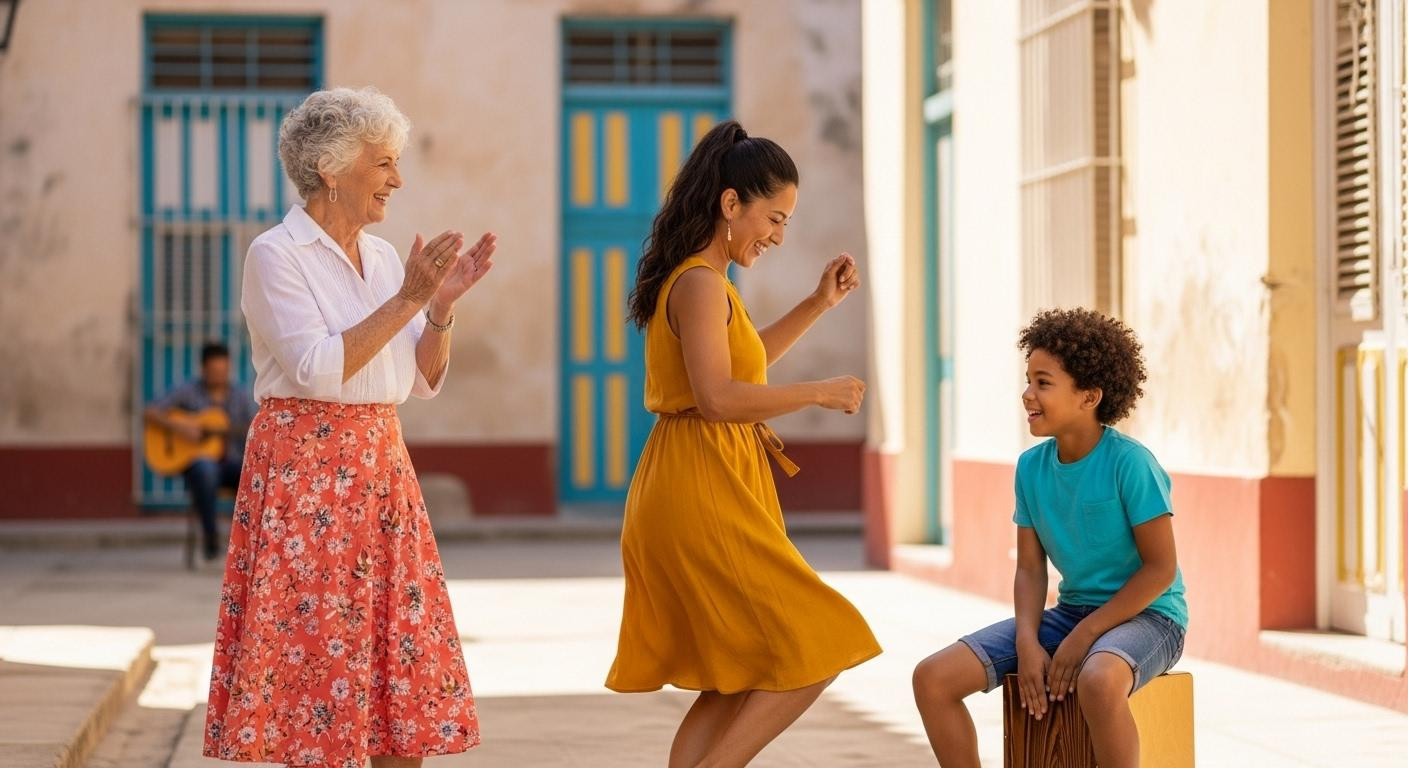Dawn breaks over Santiago de Cuba’s Tivoli district as guitar strings echo from weathered balconies. A grandmother arranges folding chairs while neighbors gather with cajónes and maracas. By 9 PM tonight, this quiet street corner will transform into rumba espontánea. The authentic Cuban celebration that 11.3 million residents experience while tourists queue for $150 Tropicana shows just 470 miles away.
Where Cuba’s real music lives after dark
The heart of authentic Cuban culture beats strongest in Santiago de Cuba’s overlooked neighborhoods. Here, spontaneous rumba gatherings bloom nightly in residential solares (courtyards) and narrow callejones (alleyways). Unlike Havana’s commercialized venues, these celebrations remain purely local.
Tivoli district harbors the most consistent gatherings. Created by French immigrants fleeing Haiti in the late 18th century, its steep cobblestone streets hide unmarked courtyards where three generations dance together. Local residents confirm that Wednesday and Sunday nights see the most activity, with music beginning around 9 PM when evening temperatures drop to 77°F.
The formal Casa de la Trova on Calle Heredia operates 12 hours daily, from 11 AM until after midnight. But the real magic happens in the back patios when tourist shows end. Musicians continue playing until sunrise, creating the Cuba that Caribbean travelers rarely discover.
The cultural traditions tourists never find
Authentic Cuban celebrations center on trova, a guitar-based ballad tradition dating back over a century. Santiago de Cuba birthed this music form, and today 16-18 musical groups across the province preserve these traditions. The afternoon sessions feature soloists with guitars and claves, while evening gatherings explode into son cubano and salsa.
Rumba de solar: courtyard drum circles
These African-rooted percussion traditions survive in residential courtyards throughout Santiago. Neighbors contribute cajónes (wooden boxes), spoons, and bottles instead of professional instruments. The intimate setting allows 20-40 participants to dance, clap, and sing together. Elders teach children rhythms passed down through generations.
Peñas: community music gatherings
Weekly neighborhood sessions where locals share son cubano and trova happen in unmarked venues. The owner of a family café operating since 1947 explains that these gatherings preserve Cuban identity. Musicians visit each other’s homes for “son musical” after formal performances end. The tradition continues every Wednesday and Sunday in Tivoli’s hidden courtyards.
How to experience Cuba’s hidden celebrations
Finding authentic gatherings requires respectful engagement with local communities. Start by visiting Casa de la Trova during afternoon sessions when admission remains free. Watch where musicians go after 11 PM, then follow at a respectful distance. Ask at bodegas (corner stores) using basic Spanish: “¿Dónde hay buena música esta noche?”
Finding spontaneous rumba gatherings
The most consistent locations include Solar “La Cumbre” at the intersection of Padre Pico and Calle San Juan. Casa de las Tradiciones near the Padre Pico stairs offers a less commercialized alternative to tourist venues. Callejón de la Trova, a narrow alleyway near Plaza de la Revolución, hosts informal jam sessions beginning around 9 PM. Free cultural traditions thrive in these authentic settings.
Local festival calendar beyond tourist guides
March brings the Pepe Sanchez International Trova Festival, but October offers the most authentic experience. Fewer tourists mean increased local participation. Recent community initiative “Soneros Sin Fronteras” connects musicians via WhatsApp groups to coordinate spontaneous gatherings throughout the city.
The music that transforms Cuban nights
As sunset paints colonial walls amber, the transformation begins. Street corners fill with neighbors carrying instruments. Children carry folding chairs while grandmothers bring homemade rum in Coca-Cola bottles. The warm Caribbean air carries guitar melodies between buildings as communities gather organically.
These gatherings cost nothing but offer infinite authenticity. While Tropicana charges $125-150 for polished spectacle, neighborhood solares provide multi-generational participation free of charge. Recent visitor surveys confirm that travelers who discover these gatherings rate them more memorable than expensive tourist shows.
The contrast remains striking. Tourist venues feature professional lighting and 500-seat capacity. Authentic gatherings happen under streetlights with 30 people dancing on uneven cobblestones. Timing matters for the best cultural experiences.
Your questions about Cuba’s cultural celebrations answered
When do neighborhood rumba gatherings happen?
Most spontaneous gatherings begin after 9 PM when temperatures drop. Wednesday and Sunday nights see the most consistent activity in Tivoli district. October through March offers peak season with less tourist interference and more local participation.
Are tourists welcome at community celebrations?
Respectful tourists receive warm welcomes when following proper etiquette. Bring small bottles of rum to share rather than offering cash payments. Learn basic Spanish phrases like “¿Me permiten?” (May I join?) and “¡Buenísimo!” (Great!) to show appreciation. Ask permission before photographing participants.
How does this compare to tourist shows?
Casa de la Trova charges 5 CUC ($6) for evening performances with 70% tourist attendance. Free neighborhood gatherings feature 100% local participation with authentic instruments and traditions. Tourist shows last 2 hours while community celebrations continue until sunrise. Authentic experiences require patience and cultural sensitivity.
At 11 PM, street corner percussion continues while vintage car headlights illuminate dancers’ shadows against colonial walls. Generations connect through rhythms unchanged for centuries. This is the Cuba locals protect through simple joy rather than admission gates.
